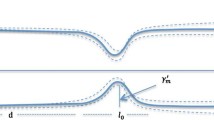Abstract
A popular and useful technique used to model blood flow in cardiovascular simulations is to divide each blood vessel into a series of segments, each with its own lumped resistance, intertance, and compliance parameters. The values of these parameters are usually obtained through a simplification of the Navier-Stokes equations for fluid flow. However, the simplification often ignores the nonlinear and convective terms of the equations, resulting in errors in the parameter values, especially in the value found for resistance per unit length. We report a new method for the calculation of vessel resistance per unit length which takes into account the effects of vessel taper and wall compliance. It is shown that these effects can be addressed by the addition of two time-varying terms to the calculation of resistance per unit length. One term, due to vessel taper, is proportional to volumetric flow rateQ. The other term, due to vessel compliance, is proportional to ∂p/∂t. These variables are readily available in computer simulations of blood flow in lumped parameter systems. Using data for the descending aorta, the new parameter values, when averaged over a cardiac cycle, compare favorably with results in the literature.
Similar content being viewed by others
Abbreviations
- i:
-
class number of parent element
- j:
-
class number of daughter element
- k :
-
branching number
- m :
-
daughter element number at one branching
- n :
-
number of pathlength group
- z :
-
generation number
- d z,i :
-
diameter of zth-generation and i-class element
- len(i):
-
length of i-class element
- N i,j :
-
observed number of j-class from i-class
- Nt:
-
total number of branching
- N el(i):
-
element number of i-class element
- N tr(i):
-
tree number of i-class element
- TNEEt :
-
total number of the exits of the model of tree
- TNEE(n):
-
total number of the exit elements of group-n
- R:
-
resistance
- Rp:
-
peripheral resistance from one exit to left atrium
- Rt:
-
total resistance from the entrance to left atrium
- Rt(n):
-
Rt when the Rp ofn-group is infinite
- Rc:
-
the imaginary resistance of the model of tree
- C 1(n):
-
the imaginary conductance of one exit vessel of n-group
- r :
-
random disit
- E i,j :
-
the matrix of mathematical expectation of branching
- a :
-
coefficient of becoming narrow
References
Barnea, O.; Moore, T.W.; Dubin, S.E.; Jaron, D.. Cardiac energy considerations during intraaortic balloon pumping. IEEE Trans. Biomed. Eng BME 37(2):170–181; 1990.
Fitch, S.; Welkowitz, W.; Hilton, R. Pulsatile blood flow in the aorta. ASME Biomedical Fluid Mechanics Symposium, Denver, CO; 1966: pp. 34–44.
Fry, D.L.. The measurement of pulsatile blood flow by the computed pressure gradient technique. IRE Trans. Med. Elect. ME-6:259–264; 1959.
Fry, D.L.; Griggs, Jr., D.M.; Greenfield, Jr., J.C.In vivo studies of pulsatile blood flow: The relationship of the pressure gradient to blood velocity. In: Attinger, E.O., ed. Pulsatile blood flow. New York: McGraw-Hill; 1964: pp. 101–114.
Fry, D.L.; Mallos, A.J.; Casper, A.G.T. A catheter tip method for measurement of the instantaneous aortic blood velocity. Circ. Res. 9:627–634; 1956.
Imaeda, K.; Goodman, F.O.. Analysis of nonlinear pulsatile blood flow in arteries. J. Biomechanics 13(12):1007–1022; 1980.
Jager, G.N.; Westerhof, N.; Noordergraaf, A. Oscillatory flow impedance in electrical analog of arterial system. Circ. Res. 16(1):121–133; 1965.
Jaron, D.; Moore, T.W.; Bai, J. Cardiovascular responses to acceleration stress: A computer simulation. IEEE Proc. 76(6):700–707; 1988.
Johnson, G.A.; Hung, T.-K.; Brant, A.M.; Borovetz, H.S. Experimental determination of wall shear rate in canine carotid arteries perfusedin vivo. J. Biomech. 22(11/12): 1141–1150; 1989.
Ling, S.C.; Atabek, H.B. A nonlinear analysis of pulsatile flowin vivo. J. Fluid Mech 55(3):493–512; 1972.
Ling, S.C.; Atabek, H.B.; Letzing, W.G.; Patel, D.J. Nonlinear analysis of aortic flow in living dogs. Circ. Res. 33(2):198–212; 1973.
McDonald, D.A. Blood flow in arteries. London: Edward Arnold; 1974.
Melbin, J.; Noordergraaf, A. Pressure gradient related to energy conversion in the aorta. Circ. Res. 52(2):143–150; 1983.
Misra, J.C.; Singh S.I. A study of the nonlinear flow of blood through arteries. Bull. Math. Biol. 49(3):257–277; 1987.
Moore, T.W.; Jaron, D.; Chu, C.-L.; Dinnar, U.; Hrebien, L.; White, M.J.; Hendler, E.; Dubin, S.E. Synchronized external pulsation for improved tolerance to acceleration stress: Model studies and preliminary experiments. IEEE Trans. Biom. Eng. BME-32(2):158–165; 1985.
O'Rourke, M.F.; Taylor, M.G. Vascular impedance of the femoral bed. Circ. Res. 18:126–139; 1966.
Patel, D.J.; DeFreitas, F.M.; Greenfield, Jr., J.C.; Fry, D.L. Relationship of radius to pressure along the aorta in living dogs. J. Appl. Physiol. 18(6):1111–1117; 1963.
Rideout, V.C.; Dick, D.E. Difference-differential equations for fluid flow in distensible tubes. IEEE Trans. Biom. BME- 14(3):171–177; 1967.
Schneck, D.J.; Ostrach, S. Pulsatile blood flow in a channel of small exponential divergence—1: The linear approximation for low mean Reynolds number. J. Fluid Eng. 97:353–360; 1975.
Strano, J.J.; Welkowitz, W.; Fish, S. Measurements utilization ofin vivo blood pressure transfer functions of dog and chicken aortas. IEEE Trans. Biomed. Eng. BME-19(4): 261–271; 1972.
Tsangaris, S.; Drikakis, D. Pulsating blood flow in an initially stressed, anisotropic elastic tube: Linear approximation of pressure waves. Med. & Biol. Eng. & Comput. 27(1):82–88; 1989.
Westerhof, N.; Bosman, F.; DeVries, C.J.; Noordergraaf, A. Analog studies of the human systemic arterial tree. J. Biomech. 2(2):121–143; 1969.
Author information
Authors and Affiliations
Rights and permissions
About this article
Cite this article
Ye, GF., Moore, T.W. & Jaron, D. Incorporating vessel taper and compliance properties in Navier-Stokes based blood flow models. Ann Biomed Eng 21, 97–106 (1993). https://doi.org/10.1007/BF02367605
Received:
Revised:
Issue Date:
DOI: https://doi.org/10.1007/BF02367605




